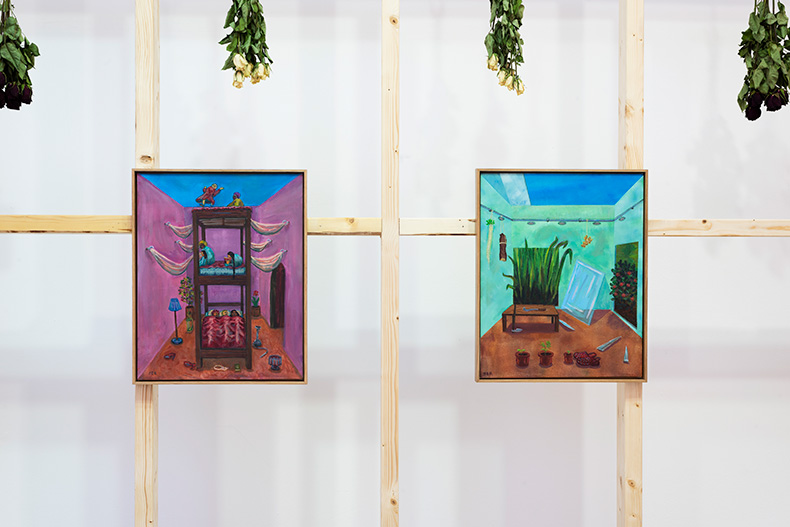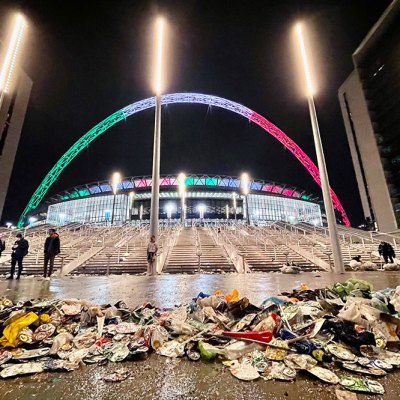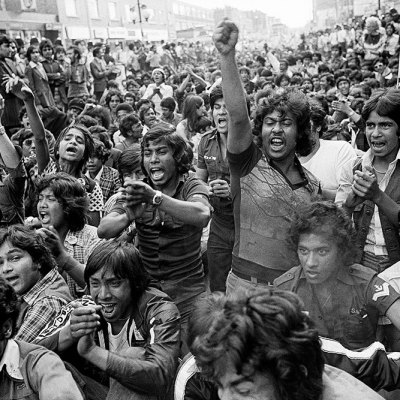The second Brent Biennial is underway, building on the success of the 2020 edition and establishing itself as a welcome fixture of the borough.
This year’s offering feels very different: more political, more focused, and perhaps a little less exuberant. The exhibits are nearly all explicitly concerned with notions of home and belonging. For a borough in which more than half of residents were born overseas, where 150 different languages are spoken, and in which austerity, poverty and the Home Office’s notorious ‘hostile environment’ policies bite hard, it’s an apt and sometimes fraught subject.
Rebecca Bellantoni’s installation, Do you have any peace for me? C.R.Y, is a case in point – a dark room populated with various domestic sculptures and ornaments hosting a film installation and repeating the written refrain ‘Have you any peace for me’ on wall hangings and carved into pottery. It’s a disturbing, stressful piece which considers how trauma might become part of domestic reality, and how the Black community has been forced to assimilate this trauma and subsume it even as it continues.
Installation view of You have any peace for me? C.R.Y. (2022) by Rebecca Bellantoni at the Brent Biennial 2002, ‘In the House of my Love’. Photo: Thierry Bal

It’s one of several pieces that consider the legacy of racism. Another, Zinzi Minott’s Fi-Dem I-V, is a video installation in a room around the back of Newman Catholic College in Harlesden, stitching four works together made for the anniversary of Windrush Day each year since 2018. It’s a powerful, dislocating experience as the glitchy video and uneven sound takes in the Windrush migrations themselves alongside footage of everyday activity, sandy beaches and domestic scenes of the diaspora. Moments of calm beauty and wholesome sociability are interspersed with those of stress and confusion.
A second major strand of this year’s Biennial is a focus on queer culture, and indeed its title, In the House of my Love, is taken from A Poem to the Nationalist Marcher (for the Queer People of Warsaw) by Ezra Green. Some works, such as Katarzyna Perlak’s wonderful installation at St Matthews Catholic Church in Harlesden, reclaim potentially hostile spaces as sites of queer inclusion. Her embellished tablecloths and Pajaki sculptures (Polish paper chandeliers) are at once completely appropriate for the chosen site, passing with ease as the gaudy adornments of faith, and challenging of its history and continued ambivalence to queer culture.
Installation view of You are a guest now (2022) by Alex Baczynski-Jenkins at the Brent Biennial 2022, ‘In the House of my Love’. Photo: Thierry Bal

Other works, while interesting, are perhaps less successful. It may add to the effect that Alex Baczynski-Jenkins’s docu-film about queer life, You are a guest now, is tucked away in a hard-to-find room in the railway arches at the top end of Kilburn High Road, but it does also make it quite hard to find, and then when it’s hard to hear as well, one wonders how much traction it can hope to achieve for all its good intentions.
The geography of the Biennial is interesting in itself. Where last year’s edition took in large parts of the borough, this iteration is much more constrained, focussed on Willesden, Harlesden and Kilburn. For this writer, who lives in Harlesden, that is a welcome development, but it’s slightly puzzling too, especially given that the Wembley Art Trail currently has an exhibition titled ‘Visions of Home’, but seemingly nothing to do with the Biennial itself.
That focus has advantages though, not least in the way the Biennial feels ingrained and integral to its location. The Tin Tabernacle in Kilburn makes a superb venue for Shenece Oretha’s In Counter Harmony, which uses this 150-year-old ‘temporary’ structure as a way of exploring how different types of community can exist alongside and even burnish each other in a communal space, through audio recordings of youth groups, community organisers and reggae choir rehearsals.
Another multi-channel sound installation, Sarah Rose’s An Open Letter of Many Replies, takes place in a hut at the side of Roundwood Park’s disused bowling green. It’s a peaceful piece, taking as its starting point letters between the American writer and conservationist Rachel Carson and her lover Dorothy Freeman, and discussing the habits of moths as an extended metaphor for invisible or forbidden ways of life and love. Lines such as ‘the declarative anatomy of the bramble’ lay it on pretty thick, but the effect is hypnotic.
Installation view of Unfurnished (2022) by Mohammed Zaahidur Rahman at the Brent Biennial 2022, ‘In the House of my Love’. Photo: Thierry Bal

I’m shortly due to leave Brent for good, moving after nearly 20 years living in the borough (coincidentally, in each of the areas in which this year’s Biennial takes place). It’s an amazing place, rich in variety and culture, and most of all, welcoming, inclusive and non-judgmental – a place to make your home and a place to feel at home.
Mohammed Zaahidur Rahman’s Unfurnished, at Kingsgate Project Space in Kilburn, captures this sense joyfully, through six paintings of notional rooms in which disparate cultures and traditions of hospitality intersect; in one, a pair of speakers from a sound system is cut in half and filled with lit candles while a person readies themself with a hammer and chisel in the background. These paintings highlight and celebrate the mess of the melange of influence in the borough and beyond, reminding us that home is not just where you are, but who you are.
The Brent Biennial 2022, ‘In the House of my Love’, is at various venues in the London Borough of Brent until 11 September.



